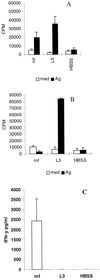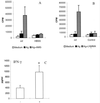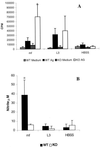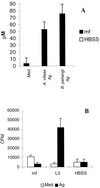NO contributes to proliferative suppression in a murine model of filariasis
- PMID: 11035712
- PMCID: PMC97686
- DOI: 10.1128/IAI.68.11.6101-6107.2000
NO contributes to proliferative suppression in a murine model of filariasis
Abstract
Infection of BALB/c mice with microfilariae (mf) of Brugia pahangi leads to the suppression of antigen (Ag)-specific proliferative responses in the spleen. The proliferative defect is dependent on inducible nitric oxide synthase (iNOS) activity, since inhibition of iNOS with either L-N-monomethyl arginine (L-NMMA) or aminoguanidine reversed defective proliferation. Splenocytes from mf-infected animals produce high levels of gamma interferon (IFN-gamma) upon in vitro restimulation with Ag, and experiments in IFN-gamma receptor-deficient (IFN-gamma R(-/-)) mice demonstrated that signaling via the IFN-gamma R is essential in the induction of NO production and subsequent proliferative suppression. Restimulation of splenocytes from mf-infected animals with an extract of Acanthocheilonema viteae, a related filarial worm which lacks endosymbiotic bacteria, also resulted in NO production and proliferative suppression, demonstrating that lipopolysaccharide of bacterial origin is not essential to the induction of iNOS activity. These results extend previous observations that infection with different life cycle stages of Brugia leads to the development of differentially polarized immune responses and demonstrate one method by which these differences may exert their effects on the proliferative potential of cells from infected animals.
Figures





Similar articles
-
Infection with Brugia microfilariae induces apoptosis of CD4(+) T lymphocytes: a mechanism of immune unresponsiveness in filariasis.Eur J Immunol. 2002 Mar;32(3):858-67. doi: 10.1002/1521-4141(200203)32:3<858::AID-IMMU858>3.0.CO;2-E. Eur J Immunol. 2002. PMID: 11870630
-
Interferon-gamma and nitric oxide production are not required for the immune-mediated clearance of Brugia malayi microfilariae in mice.Parasite Immunol. 2002 Jun;24(6):329-36. doi: 10.1046/j.1365-3024.2002.00464.x. Parasite Immunol. 2002. PMID: 12102718
-
Nitric oxide limits the expansion of antigen-specific T cells in mice infected with the microfilariae of Brugia pahangi.Infect Immun. 2002 Nov;70(11):5997-6004. doi: 10.1128/IAI.70.11.5997-6004.2002. Infect Immun. 2002. PMID: 12379675 Free PMC article.
-
Nitric oxide-induced apoptotic cell death in the acute phase of Trypanosoma cruzi infection in mice.Immunol Lett. 1998 Sep;63(2):113-20. doi: 10.1016/s0165-2478(98)00066-2. Immunol Lett. 1998. PMID: 9761373
-
Role of macrophage-derived nitric oxide in suppression of lymphocyte proliferation during blood-stage malaria.J Leukoc Biol. 1995 Jul;58(1):23-31. doi: 10.1002/jlb.58.1.23. J Leukoc Biol. 1995. PMID: 7542305
Cited by
-
A Dirofilaria immitis polyprotein up-regulates nitric oxide production.Infect Immun. 2002 Sep;70(9):5283-6. doi: 10.1128/IAI.70.9.5283-5286.2002. Infect Immun. 2002. PMID: 12183583 Free PMC article.
-
Resistance and susceptibility to filarial infection with Litomosoides sigmodontis are associated with early differences in parasite development and in localized immune reactions.Infect Immun. 2003 Dec;71(12):6820-9. doi: 10.1128/IAI.71.12.6820-6829.2003. Infect Immun. 2003. PMID: 14638768 Free PMC article.
-
Similarity and diversity in macrophage activation by nematodes, trematodes, and cestodes.J Biomed Biotechnol. 2010;2010:262609. doi: 10.1155/2010/262609. Epub 2010 Jan 26. J Biomed Biotechnol. 2010. PMID: 20145705 Free PMC article. Review.
-
Differential cytokine and antibody responses to adult and larval stages of Onchocerca volvulus consistent with the development of concomitant immunity.Infect Immun. 2002 Jun;70(6):2796-804. doi: 10.1128/IAI.70.6.2796-2804.2002. Infect Immun. 2002. PMID: 12010965 Free PMC article.
-
The effect of declining exposure on T cell-mediated immunity to Plasmodium falciparum - an epidemiological "natural experiment".BMC Med. 2016 Sep 22;14(1):143. doi: 10.1186/s12916-016-0683-6. BMC Med. 2016. PMID: 27660116 Free PMC article.
References
-
- Albina J E, Mateo R B, Reichner J S. Nitric oxide-mediated apoptosis in murine peritoneal macrophages. J Immunol. 1993;150:5080–5085. - PubMed
-
- Allen J, Lawrence R A, Maizels R M. APC from mice harboring the filarial parasite, Brugia malayi, prevent cellular proliferation but not cytokine production. Int Immunol. 1996;8:143–151. - PubMed
-
- Allione A, Bernabei P, Bosticardo M, Fornii G, Novelli F. Nitric oxide suppresses human T lymphocyte proliferation through IFN-γ dependent and IFN-γ independent induction of apoptosis. J Immunol. 1999;163:4182–4191. - PubMed
-
- Corbett J A, Tilton R G, Chang K C, Hasan K S, Ido Y, Wang J I, Sweetland M A, Lancaster J R, Williamson J R, McDaniel M L. Aminoguanidine, a novel inhibitor of nitric oxide formation, prevents diabetic vascular dysfunction. Diabetes. 1992;41:552–556. - PubMed
Publication types
MeSH terms
Substances
Grants and funding
LinkOut - more resources
Full Text Sources
Molecular Biology Databases

